Abstract
As climate change continues to alter species distributions, Pinus bungeana, an endangered conifer of significant ecological and ornamental value, faces heightened vulnerability, underscoring the critical need to understand and predict its future habitat shifts. Here, we used 83 effective geographic distribution records, along with climate, topography, soil, and drought indices, to simulate the potential distribution of suitable ecological niches for P. bungeana under current conditions and across three future time periods (2040–2060, 2060–2080, and 2080–2100) under two shared socioeconomic pathways: SSP126 (low emissions) and SSP585 (high emissions), using the maximum entropy (MaxEnt) model. The results show that the area under the receiver operating characteristic curve (AUC) for all simulations exceeded 0.973, indicating high predictive accuracy. Soil moisture, the minimum temperature of the coldest month, temperature seasonality, isothermality, the precipitation of the wettest quarter, and altitude were identified as key environmental factors limiting the distribution of P. bungeana, with soil moisture and the minimum temperature of the coldest month being the most important factors. Under the current climatic conditions, the potentially suitable ecological niches for P. bungeana were primarily located in Shaanxi Province, southern Shanxi Province, southeastern Gansu Province, northeastern Sichuan Province, Henan Province, and northwestern Hubei Province, covering approximately 75.59 × 104 km2. However, under the future climate scenarios, highly suitable areas were projected to contract, with the rate of decline varying significantly between scenarios. Despite this, the total area of potentially suitable ecological niches was predicted to expand in the future periods. Additionally, a pronounced eastward shift in P. bungeana’s distribution was projected, especially under the high-emission SSP585 scenario. These findings provide insights into the potential impacts of climate change on the distribution of P. bungeana, and they offer valuable guidance for its conservation strategies and habitat management in the context of climate change.
1. Introduction
Endemic species are crucial components of regional biodiversity and play a vital role in maintaining ecosystem functionality [1,2]. However, due to their specialized habitats, narrow environmental tolerance, and unique ecological requirements [3], they are highly vulnerable to environmental changes. As indicated in the Sixth Assessment Report of the United Nations Intergovernmental Panel on Climate Change (IPCC), if greenhouse gas emissions continue at the current rate, global warming could reach 2.2–3.5 °C by 2100. Notably, China is expected to experience a warming rate higher than the global average [4,5]. This climate change directly and indirectly modifies the biotic and abiotic factors that determine habitat suitability, leading to significant changes in species’ geographic distributions, range shifts, and population dynamics [6,7,8,9,10]. Plant species, especially endemic ones, may respond slowly to rapid climate changes in terms of their ecological niches and adaptive capacities [9,10]. Thus, understanding the impact of climate change on the biogeographic patterns of endemic species is of utmost importance, serving as the basis for formulating species-specific conservation strategies, optimizing natural resource utilization, and developing effective ecosystem stewardship and biodiversity preservation strategies in the face of environmental changes [11,12,13].
Species distribution modeling (SDM) has become an essential and powerful tool to understand the profound impacts of environmental changes on species [12,13]. SDM integrates corresponding algorithms with species’ geographical distribution obtained from field surveys, herbarium records, and the literature. It then predicts bio-ecological niches and expresses species’ habitat preferences probabilistically based on the density of distribution points [14]. Commonly utilized methods include bioclimatic modeling (BIOCLIM) [15], maximum entropy (MaxEnt) modeling [16], the genetic algorithm for the ruleset prediction model (GARP) [17], generalized adjoint modeling (GAM) [18], and generalized linear modeling (GLM) [19]. Among these, MaxEnt has gained widespread popularity due to its higher tolerance and prediction accuracy [3,20,21,22,23]. Its principle is rooted in the concept of entropy in information theory, where entropy represents uncertainty. The MaxEnt model selects the probability distribution with the largest entropy under known constraints, effectively balancing the model’s complexity with the data fit and reducing over-reliance on prior assumptions [20,24]. This makes MaxEnt particularly suitable for predicting the distribution of species with limited occurrence data, such as endemic and endangered species.
Pinus bungeana is an endemic, rare, and endangered conifer in China and the only three-needle pine species in East Asia [25,26,27], thus providing an ideal material for studying the impact of climate change on endemic species. It is distributed in the rock crevices, ridges, or slopes of Qinling, Daba, and Taihang Mountains, ranging from 800 to 1300 m above sea level. P. bungeana also plays a significant role in maintaining the stability of arid ecosystems in western and northern China, particularly in calcareous mountainous areas. Its remarkable adaptability to drought, cold, and nutrient-poor soils makes it an ideal species for ecological restoration, gardening, and afforestation projects [28,29,30]. Unfortunately, in recent decades, P. bungeana has faced a significant range contraction and population decline. Its remaining populations are mainly small, isolated habitat fragments with distinct spatial discontinuities [31,32,33]. This fragmentation is attributed to various factors, including climatic fluctuations, tree senescence, limited population regeneration, and human disturbances [33]. Furthermore, some studies have suggested that climate change will reduce the genetic diversity of P. bungeana, potentially weakening its adaptive capacity and accelerating its extinction [34]. Given the importance of understanding climate change impacts on endemic species and the utility of SDM in such research, it is critical to assess and predict the potentially suitable ecological niches of P. bungeana under different climate scenarios.
Previous studies on the distribution of P. bungeana’s suitable ecological niches have primarily focused on climatic factors and lacked an analysis of continuous and dynamic future trends [35]. To address this gap, this study employed the MaxEnt model to incorporate a comprehensive set of environmental factors, including climate, soil, topography, and drought-related variables, to predict the current and future distributions of P. bungeana’s suitable ecological niches. Two shared socioeconomic pathways, SSP126 and SSP585, were selected for simulation within the Coupled Model Intercomparison Project (CMIP6). SSP126 represents a sustainable development pathway with moderate greenhouse gas (GHG) emissions, limiting warming to 2 °C, while SSP585 represents a high GHG emission scenario with conventional development, limiting warming to 5 °C [36,37]. These scenarios were chosen for an accurate simulation of temperature and precipitation patterns in China. The main objectives were as follows: (1) to identify the dominant environmental factors affecting the distribution of P. bungeana and to quantify its suitable range, (2) to analyze the spatial distribution characteristics of P. bungeana and the trajectory of the center-of-mass movement of its suitable ecological niches under current and future climate conditions, and (3) to predict the changing trend of the suitable ecological niches for P. bungeana under climate change. Based on these findings, we provide conservation and management recommendations, offering a reference for the future conservation of P. bungeana in China.
2. Materials and Methods
2.1. Occurrence Records of Species Distribution
The distribution records of P. bungeana used in this study were obtained from the Chinese Virtual Herbarium (CVH, https://www.cvh.ac.cn/, accessed on 23 November 2023), the Global Biodiversity Information Facility (GBIF, http://www.gbif.org/, accessed on 23 November 2023), and the relevant literature. To ensure data accuracy, a series of screening steps was implemented. Records lacking any effective distribution information, those obviously outside the natural distribution range, or those with species identification errors—identified through a visual check of available species photographs—were excluded. For records where only location information without geographic coordinates was available, we manually extracted the longitude and latitude coordinates (https://api.map.baidu.com/lbsapi/getpoint/index.html, accessed on 1 December 2023). Additionally, the “ENMTools” R package (v.1.1.2) was employed to further filter the collected distribution records of P. bungeana, ensuring that only one distribution record per 2.5′ × 2.5′ grid cell was included, thereby improving the model’s predictive accuracy of geographic distribution [38]. After applying these screening criteria, a total of 83 valid distribution points were selected to construct the species distribution model of P. bungeana (Figure 1).
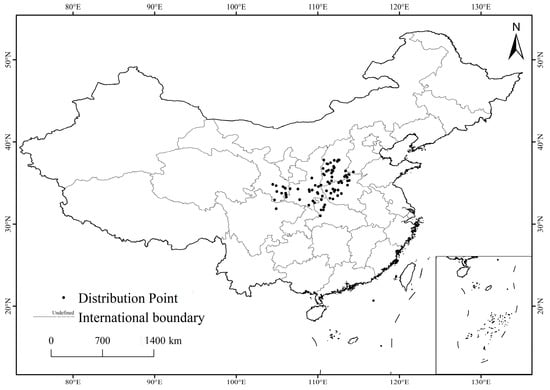
Figure 1.
Geographic distribution of occurrence sites of Pinus bungeana in China. Note: The base map was created in accordance with the standard map issued by the Ministry of Natural Resources of the People’s Republic of China (review number GS (2020)4619). No modifications were made to the base map boundaries. This standard applies to all subsequent figures.
2.2. Environmental Data Acquisition and Processing
The ecological niche of a species is determined by its adaptive range across various environmental factors; generally, the more environmental factors that are considered, the more accurately the species distribution can be predicted. A large body of literature has shown that climate, soil, topography, and drought-related factors significantly influence the distribution and ecological niche of the genus Pinus [39,40]. Therefore, four categories of environmental factors, namely, climate, soil, topography, and drought-related factors, were selected (Table 1). A total of 19 bioclimatic factors were obtained with a 30″ spatial resolution from the WorldClim Global Climate Database (https://www.worldclim.org/, accessed on 23 November 2023) for current (1970–2000s) and future (2040–2060s, 2060–2080s, and 2080–2100s) scenarios. Two shared socioeconomic pathway climate scenarios (SSP126 and SSP585) published by the 6th International Coupled Model Intercomparison Programmer (CMIP6) were selected to estimate future climate change. Compared to the CMIP5 model, the CMIP6 model provides better simulations of the daily frequency distributions of all types of precipitation [41]. A total of 18 soil factors were obtained from the HWSD raster dataset of the Harmonized World Soil Database (HWSD v2.0) provided by the International Food and Agriculture Organization (https://www.fao.org/soils-portal/data-hub/soil-maps-and-databases/harmonized-world-soil-database-v20/en/, accessed on 14 June 2024). Three topographic factors were obtained from the Global Soil Properties Database (https://sage.nelson.wisc.edu/data-and-models/atlas-of-the-biosphere/mapping-the-biosphere/ecosystems/topography/, accessed on 14 June 2024) using the 3D Analyst tool in ArcGIS 10.8 for analysis and generation. Two drought factors were obtained from the CGIAR-CSI Geoportal (https://csidotinfo.wordpress.com/2019/01/24/global-aridity-index-and-potential-evapotranspiration-climate-database-v3/, accessed on 14 June 2024).

Table 1.
Environmental factors used in the species distribution modeling.
High multicollinearity among environmental factors may lead to model overfitting, which can undermine the predictive accuracy of statistical models. Therefore, prior to formal modeling, we screened the 42 environmental factors. To address potential overfitting caused by multicollinearity, we employed a two-step screening procedure: (1) The 42 environmental factors were imported into the MaxEnt 3.4.4 model (https://www.gbif.org/tool/81279/maxent, accessed on 14 June 2024, American Museum of Natural History, New York, NY, USA), and analyses were repeated 10 times to rank the contribution rates of each factor. The environmental factors with a contribution rate of 0 were deleted. (2) We then conducted a correlation analysis on the remaining environmental variables. When the absolute value of the correlation coefficient between any two environmental variables exceeded 0.8, this indicated a high degree of linear association, which might cause overfitting. In such cases, we carried out a contribution assessment [42,43]. The environmental variable with a comparatively lower contribution to the overall model performance was systematically excluded to optimize the variable set and enhance the model’s efficiency. Ultimately, 19 environmental factors were used for modeling (Figure 2).
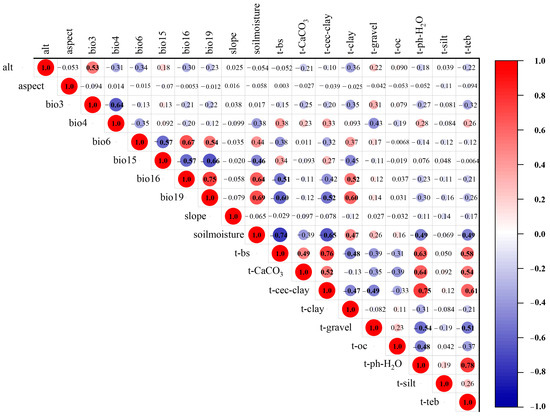
Figure 2.
Correlation heat map of environmental factors used in species distribution modeling. Significant correlations (p < 0.05) are marked in bold.
2.3. Species Distribution Modeling and Assessment
The MaxEnt model was used to predict the potential geographic distribution range of P. bungeana. The processed sample data and environmental factors were entered into the model. For model training, 75% of the species occurrence data were randomly selected, while 25% were reserved as test data [44]. The maximum number of background points was set to 10,000, and the maximum number of iterations was set to 5000, with more than 10 loops being executed [45]. The model’s accuracy was evaluated using the area under the curve (AUC) of the receiver operating characteristic (ROC) curve, a widely recognized metric that reflects a model’s predictive performance [46]. The AUC ranges from 0 to 1, with values closer to 1 indicating better prediction accuracy. The following was applied: an AUC of 0.50 to 0.70 was considered poor, 0.70 to 0.80 was considered reasonable, 0.80 to 0.90 was considered good, and 0.90 to 1.00 was considered excellent prediction performance.
The Jackknife test was used to assess the importance of climate variables on species distribution [44,45]. Key environmental factors were further analyzed using response curves, which describe the relationship between the probability of species presence and the threshold range of ecological factors [47]. These curves clearly illustrate the appropriate distribution range of a species in relation to environmental variables. Additionally, we analyzed the relationships between the probability of survival and environmental factors that could provide valuable insights into their specific influence on the species’ habitat preferences. When the survival probability of the species exceeded 0.5, the corresponding environmental variables were considered favorable for its growth and distribution [48].
The MaxEnt model outputted the probability of species presence on a scale from 0 to 1. To minimize the variance within the same class and maximize the variance between different classes, the Natural Breaks method [49] in the ArcGIS 10.8 spatial analysis tool was used to classify the suitable levels; then, combined with the natural distribution area of P. bungeana, the distribution was divided into 4 classes: (0.00 to 0.10) for non-suitable ecological niches, (0.10 to 0.33) for low-suitable ecological niches, (0.33 to 0.64) for the medium fecundity zone, and (0.64 to 1.00) for high-suitable niches. For the future climate scenarios, the classification of suitability levels remained consistent with the current classification. The Reclassify tool in ArcGIS 10.8 was then used to calculate the distribution area under the current and future climate scenarios and to map the distribution of potentially suitable ecological niches.
3. Results
3.1. Evaluation of Model Accuracy
The AUC value was 0.973 for the training dataset under the current climate (Figure 3 and Table 2). The future climate change scenarios also yielded AUC values that exceeded 0.97 across different future periods (Table 2), indicating high prediction accuracy for all scenarios.
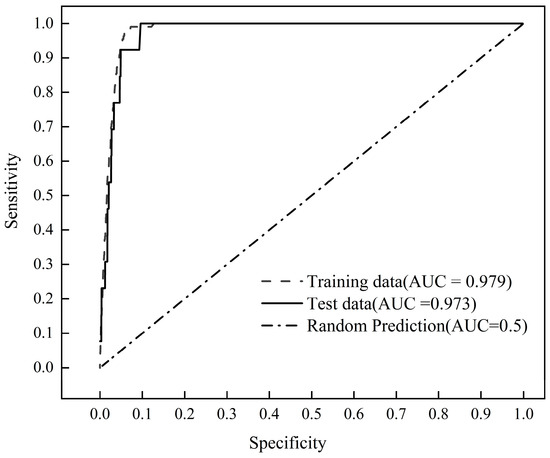
Figure 3.
Receiver operating characteristic (ROC) curve for the predicted current distribution of Pinus bungeana using the MaxEnt model.

Table 2.
AUC values for the predicted potential distribution of Pinus bungeana under current and future climate scenarios.
3.2. Dominant Factors Influencing the Distribution of Pinus bungeana
Under the current climate, the top five contributing environmental factors were soil moisture (soilmoisture, 23.4%), the minimum temperature of the coldest month (bio6, 20.9%), temperature seasonality (bio4, 8.8%), isothermality (bio3, 8.7%), and altitude (alt, 8.4%) (Table 3). Together, these factors accounted for 70.2% of the predicted distribution patterns of P. bungeana. The Jackknife test confirmed that bio6, bio3, soilmoisture, the precipitation of the wettest quarter (bio16), and bio4 were the top five contributors under the current climate (Figure 4). Similarly, soilmoisture, bio6, bio4, bio3, alt, and bio16 were also the primary environmental factors under the two emission pathways (SSP126 and SSP585) in the future time periods. Notably, the contribution of soilmoisture and bio6 exceeded 20% in most scenarios and significantly surpassed that of the other environmental factors.

Table 3.
Contribution rate of each environmental factor to the distribution of Pinus bungeana based on the MaxEnt model.
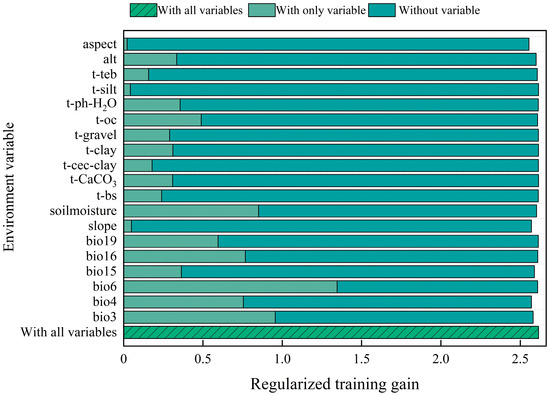
Figure 4.
Jackknife test results showing the relative importance of environmental factors in predicting the distribution of Pinus bungeana.
Under the current climate scenario, the suitable environmental ranges were 24~68 mm for soilmoisture and −13~17 °C for bio6, with optimum environmental values of c. 27 mm for soilmoisture and c. −1 °C for bio6 (Figure 5). In the future climate scenarios, the suitable range of soilmoisture for P. bungeana was basically stable at 24 to 68 mm, while the suitable range of bio6 gradually narrowed with the increase in emissions (Figure 6 and Figure 7). Additionally, the suitable range was −8 to 16 °C under SSP126 and −5 to 14 °C under SSP585 in the 2040–2060 period, −15 to 14 °C under SSP126 and −6 to 11 °C under SSP585 in the 2060–2080 period, and −13 to 14 °C under SSP126 and −5 to 9 °C under SSP585 in the 2080–2100 period.

Figure 5.
Response curves of dominant environmental factors influencing the distribution of Pinus bungeana under current climatic conditions. Gray shade indicates 95% confidence interval.
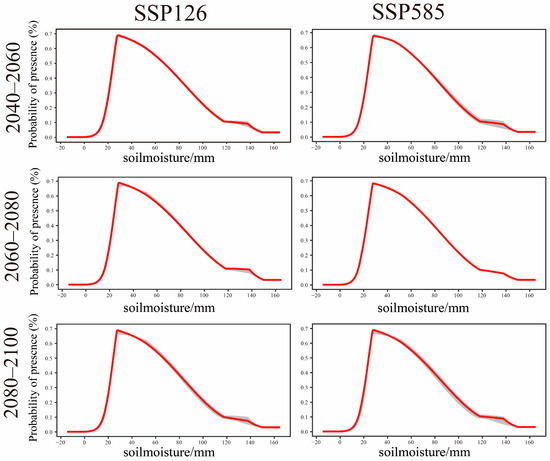
Figure 6.
Response curves of soil moisture influencing the distribution of Pinus bungeana under future climate change scenarios. Gray shade indicates 95% confidence interval.
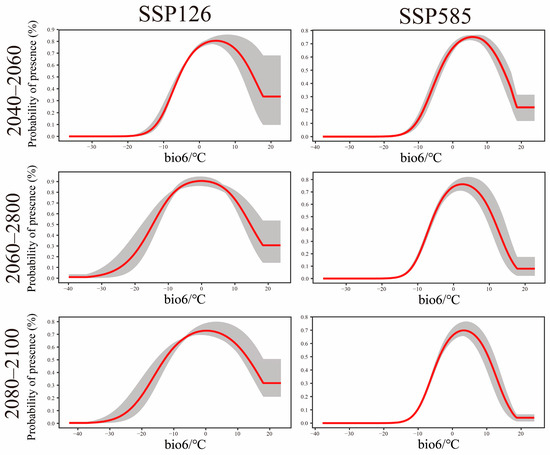
Figure 7.
Response curves of the minimum temperature of the coldest month influencing the distribution of Pinus bungeana under future climate change scenarios. Gray shade indicates 95% confidence interval.
3.3. Current Distribution of Pinus bungeana
Under the current climatic conditions, the potential suitable ecological niches of P. bungeana in China were mainly distributed in Shaanxi Province, southern Shanxi Province, northwestern Henan and Hubei Provinces, and southeastern Gansu Province, with an area of about 75.59 × 104 km2, accounting for about 7.87% of the national land area (Figure 8 and Table 4). Within its distribution, the medium- and high-suitable ecological niches were mainly distributed in southeastern Gansu Province, south-central Shaanxi Province, south-central Shanxi Province, northwestern Henan Province, and northwestern Hunan Province, with an area of about 36.12 × 104 km2, accounting for 47.78% of the suitable ecological niche.
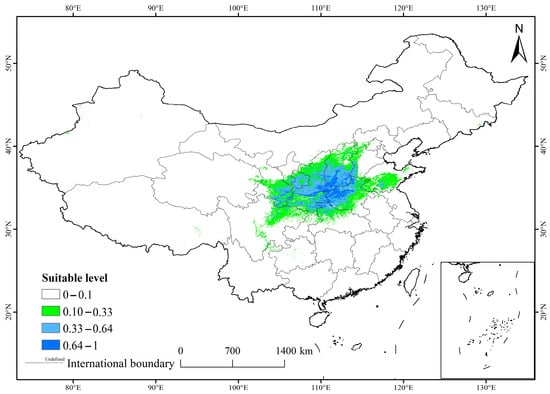
Figure 8.
Distribution of suitable ecological niches of Pinus bungeana under current climatic conditions in China.

Table 4.
Potential suitable area of Pinus bungeana under different climate scenarios in the future.
3.4. Potential Geographic Distribution of Pinus bungeana Under Future Climate Scenarios
The total potential distribution ranges of P. bungeana showed different degrees of expansion under the two carbon emission pathways (SSP126 and SSP585) in all time periods (Figure 9). Among all time periods, the greatest expansion occurred during the 2040–2060 period, with increases of 10.68% under SSP126 and 8.38% under SSP585, while the smallest expansion occurred during the 2060–2080 period, with increases of 0.51% under SSP126 and 4.56 under SSP585. Between the two carbon emission pathways, the degree of expansion under SSP126 was higher than that under SSP585, except for during the 2060–2080 period. Similar to the total distribution under the two different carbon emission pathways in the three future time periods, low- and medium-suitable ecological niches showed expansion trends; in contrast, high-suitable ecological niches showed contraction trends, specifically decreasing by 12.86% under SSP126 during the 2040–2060 period and by 18.44% under SSP585 during the 2060–2080 period (Table 4).
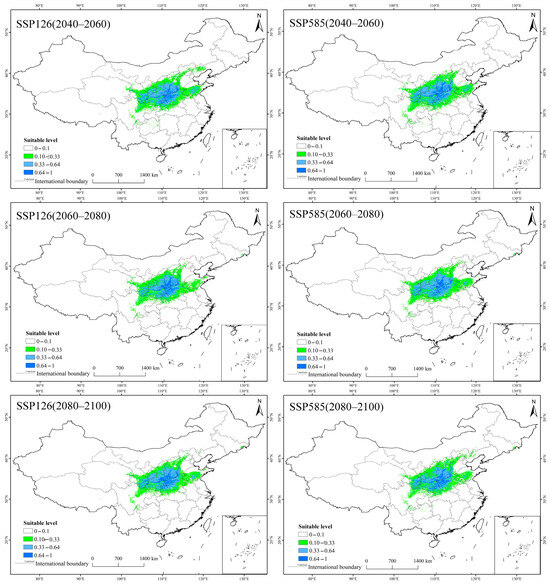
Figure 9.
Predicted suitable distribution areas of Pinus bungeana under future climate scenarios.
3.5. Shift in the Center-of-Mass of Potentially Suitable Ecological Niches in Pinus bungeana
To assess potential geographic shifts, we also analyzed the center-of-mass of P. bungeana’s suitable habitats under both current and projected future climate conditions (Figure 10). Under the current climatic conditions, the center-of-mass of the potentially suitable ecological niche of P. bungeana was located near Lantian County, Shaanxi Province at 34.15° N, 109.34° E. In the future, under SSP126, it was found that the center-of-mass was located at 34.09° N, 109.44° E during the 2040–2060 period; 33.95° N, 109.77° E during the 2060–2080 period; and 34.20° N, 109.87° E during the 2080–2100 period. Compared to the present, the distribution of P. bungeana shifted southeastward by 11.1 km and 47.73 km during the 2040–2060 and 2060–2080 periods, respectively, and it then shifted northeastward by 58.83 km during the 2080–2100 period. Under SSP585, the center-of-mass was located at 34.13° N, 109.95° E during the 2040–2060 period; 33.95° N, 109.77° E during the 2060–2080 period; and 34.45° N, 110.13° E during the 2080–2010 period. Compared to the present, the distribution of P. bungeana shifted eastward by 67.71 km during the 2040–2060 period, and it then shifted northeastward by 85.47 km during the 2060–2080 period and by 87.69 km during the 2080–2010 period. Overall, in the future, it is projected that P. bungeana will initially migrate eastward and then shift northeast. Moreover, the migration distance under the SSP585 scenario is predicted to be larger than under the other scenarios.
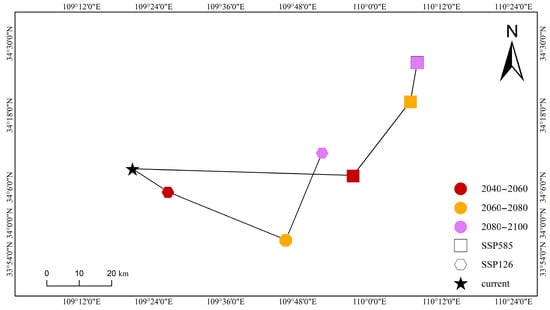
Figure 10.
Center-of-mass movement of suitable ecological niches for Pinus bungeana under different climatic scenarios.
4. Discussion
Endemic species play a vital role in maintaining ecosystem function and services [1,2], yet their restricted geographic ranges render them particularly vulnerable to climate change [50]. P. bungeana, endemic to west-central China, is listed among the threatened higher plants of China. This study applied the MaxEnt model to simulate the potential distribution of suitable ecological niches for P. bungeana under different climate scenarios and identified the dominant environmental factors restricting its distribution.
Our findings suggest that the dominant environmental factors limiting the distribution of P. bungeana under the current climatic conditions are soil moisture and the minimum temperature of the coldest month, which is consistent with previous studies in other Pinus species [51,52]. P. bungeana is naturally distributed in mountainous regions with a cold climate, thereby granting it strong cold resistance [30]. As a species in the genus Pinus, P. bungeana thrives under low temperatures, which are conducive to its dispersal and differentiation. If temperatures rise, the P. bungeana population would likely decrease, and in severe cases, this may even lead to the extinction of some local populations. Soil moisture also plays a crucial role in the species’ growth, development, and survival. The state of the soil water content can even affect tree growth in the early part of the next growing season [53]. However, in rocky mountainous regions, soil moisture is generally low and fluctuates rapidly. Furthermore, our analysis showed that temperature seasonality, isothermality, altitude, and precipitation during the wettest quarter also significantly influenced the distribution of P. bungeana. Precipitation during the growing season is the primary source of soil moisture [54]. Meanwhile, temperature and precipitation together are essential in regulating soil moisture [55]. In addition, elevation plays an indirect role by influencing temperature and precipitation [56]. Hence, these six environmental variables together suggest that temperature and humidity are the main factors affecting the distribution of P. bungeana. This is consistent with the findings by Li et al. [57], who found temperature and precipitation to be the dominant environmental factors affecting the distribution of five rare and endangered genus Pinus in China. Moreover, the seeds of P. bungeana have physiological dormancy characteristics that cause difficulties in germination [29,58]. Generally, low-temperature treatments or winter cold processes can break seed dormancy, whereas high temperatures may inhibit seed germination [58]. In the context of global warming, high early-growing season temperatures could lead to physiological water deficits affecting the growth and development of P. bungeana. Additionally, high temperatures may also induce heat stress or heat injury, further impairing tree development [59].
The prediction indicated that, under the current climatic conditions, the medium- and high-suitable ecological niches of P. bungeana in China were mainly distributed in southeastern Gansu, Shanxi, Shaanxi, Henan, northern Sichuan, and western Hubei. These results closely match the current natural distribution points of the species, indicating high prediction accuracy [60]. The total area of potentially suitable ecological niches under the current climate was 75.59 × 104 km2. With global warming, some studies have shown that tree growth in cold environments would be promoted [1,61]. We observed similar results for P. bungeana, as the areas of medium- and high-suitable ecological niches tended to increase in the context of future climate change, except under the low-emission pathway in 2060–2080. However, the distribution areas of high-suitable ecological niches for P. bungeana were reduced to different degrees.
Another important aspect in our findings was the predicted eastward shift in the potential distribution range of suitable ecological niches for P. bungeana under future climate scenarios. This shift was expected to speed up with rising temperatures, especially in high-emission scenarios. For instance, the largest migration for the species’ center-of-mass, about 87.69 km, was predicted to occur from 2080 to 2100 under the high-emission scenario (Figure 10). This eastward migration was primarily driven by warming and increased rainfall, which enhanced soil moisture [62], a trend observed in other studies of Pinus species [63,64]. Although some arid and semi-arid regions may experience increased precipitation, the combination with faster warming could induce drought conditions [65]. The combined effects of drought and warming could exacerbate the risk of physiological drought in P. bungeana, resulting in a reduction in its suitable ecological niches’ distribution in the western part. In contrast, there may be a gradual increase in intense rainfall in the eastern part of the distribution area [66], replenishing soil moisture and offsetting the negative impact of higher temperatures on P. bungeana’s survival. The 400 mm isothermal rainfall line could influence the northern boundary of the distribution, causing the center-of-mass of P. bungeana to shift eastward in response to climate change. The dominant environmental factors limiting the potentially suitable ecological niches for P. bungeana were mainly soil moisture (humidity) and the minimum temperature of the coldest month (temperature), with both contributing to a similar extent. Previous studies have shown that, when temperature and humidity are favorable, trees tend to be less sensitive to fluctuations in these variables, making them less vulnerable to climate-induced shifts [67,68]. However, with accelerated warming, the ecological niches of P. bungeana may become increasingly unstable, particularly under high-emission pathways. Hence, effective conservation strategies must consider these shifting patterns and focus on maintaining habitat connectivity to support future adaptation.
5. Conclusions
Our study investigated the distribution of P. bungeana in response to climate change in China. The results indicate that soil moisture and low temperatures are dominant environmental factors affecting the current distribution of P. bungeana. Under current climate conditions, the potential suitable ecological sites for P. bungeana were primarily distributed in southeastern Gansu, Shanxi, Shaanxi, Henan, northern Sichuan, and western Hubei. The area of the potential suitable ecological sites was 75.59 × 104 km2, of which the area of medium- and high-suitable ecological sites was 36.12 × 104 km2. Under future climate scenarios, species’ suitable ecological niches expanded and shifted eastward. However, the areas of highly suitable ecological niches were predicted to contract, with varying trends between the climate scenarios. These findings provide a basis for recommendations for future conservation strategies for the endemic and endangered P. bungeana.
Author Contributions
X.Z. (Xiaowei Zhang) and Y.F. designed and performed the research framework, analyzed the data, and wrote and prepared the original draft. X.W. and X.Z. (Xiaolei Zhou) designed and supervised the study, reviewed the manuscript, and approved the final draft. F.N. participated in data analysis and reviewed the manuscript draft, providing critical comments and language proofreading. W.D. and S.L. collected species occurrence records. All authors have read and agreed to the published version of the manuscript.
Funding
This research work was supported by grants from the Science and Technology Innovation Fund of Gansu Agricultural University (GAU-KYQD-2020-13) and the National Natural Science Foundation of China (31860197).
Data Availability Statement
Data are contained within the article.
Conflicts of Interest
The authors declare no conflicts of interest.
References
- Silva, L.C.R.; Sun, G.; Zhu-Barker, X.; Liang, Q.L.; Wu, N.; Horwath, W.R. Tree growth acceleration and expansion of alpine forests: The synergistic effect of atmospheric and edaphic change. Sci. Adv. 2016, 2, e1501302. [Google Scholar] [CrossRef] [PubMed]
- Myers, N.; Mittermeier, R.A.; Mittermeier, C.G.; da Fonseca, G.A.B.; Kent, J. Biodiversity hotspots for conservation priorities. Nature 2000, 403, 853–858. [Google Scholar] [CrossRef] [PubMed]
- Habibullah, M.S.; Din, B.H.; Tan, S.H.; Zahid, H. Impact of climate change on biodiversity loss: Global evidence. Environ. Sci. Pollut. Res. 2022, 29, 1073–1086. [Google Scholar] [CrossRef]
- IPCC. Summary for Policymakers in Climate Change 2021: The Physical Science Basis. Contribution of Working Group to the Sixth Assessment Report of the Intergovernmental Panel on Climate Change; Cambridge University Press: Cambridge, UK, 2021. [Google Scholar]
- Dong, Y.Y.; Zhai, J.Q.; Zhao, Y.; Liu, Z.W.; Yang, Q.; Jiang, S.; Lv, Z.Y.; Yan, D.Y.; Liu, K.; Ding, Z.Y. Impacts of large-scale circulation patterns on the temperature extremes in the cold regions of China with global warming. Front. Earth Sci. 2023, 11, 1120800. [Google Scholar] [CrossRef]
- Li, J.Y.; Chang, H.; Liu, T.; Zhang, C. The potential geographical distribution of Haloxylon across Central Asia under climate change in the 21st century. Agr. Forest Meteorol. 2019, 275, 243–254. [Google Scholar] [CrossRef]
- Bellard, C.; Bertelsmeier, C.; Leadley, P.; Thuiller, W.; Courchamp, F. Impacts of climate change on the future of biodiversity. Ecol. Lett. 2012, 15, 365–377. [Google Scholar] [CrossRef] [PubMed]
- Lamsal, P.; Kumar, L.; Shabani, F.; Atreya, K. The greening of the Himalayas and Tibetan Plateau under climate change. Glob. Planet. Change 2017, 159, 77–92. [Google Scholar] [CrossRef]
- He, X.; Burgess, K.S.; Yang, X.F.; Ahrends, A.; Gao, L.M.; Li, D.Z. Upward elevation and northwest range shifts for alpine Meconopsis species in the Himalaya–Hengduan Mountains region. Ecol. Evol. 2019, 9, 4055–4064. [Google Scholar] [CrossRef]
- Quintero, I.; Wiens, J.J. Rates of projected climate change dramatically exceed past rates of climatic niche evolution among vertebrate species. Ecol. Lett. 2013, 16, 1095–1103. [Google Scholar] [CrossRef]
- Xu, Y.; Lu, Y.G.; Zou, B.; Xu, M.; Feng, Y.X. Unraveling the enigma of NPP variation in Chinese vegetation ecosystems: The interplay of climate change and land use change. Sci. Total Environ. 2024, 912, 169023. [Google Scholar] [CrossRef]
- Jiménez-Alfaro, B.; Draper, D.; Nogués-Bravo, D. Modeling the potential area of occupancy at fine resolution may reduce uncertainty in species range estimates. Biol. Conserv. 2012, 147, 190–196. [Google Scholar] [CrossRef]
- Wiens, J.A.; Stralberg, D.; Jongsomjit, D.; Howell, C.A.; Snyder, M.A. Niches, models, and climate change: Assessing the assumptions and uncertainties. Proc. Natl. Acad. Sci. USA 2009, 106 (Suppl. S2), 19729–19736. [Google Scholar] [CrossRef] [PubMed]
- Elith, J.H.; Graham, C.P.; Anderson, R.; Dudík, M.; Ferrier, S.; Guisan, A.J.; Hijmans, R.; Huettmann, F.R.; Leathwick, J.; Lehmann, A.; et al. Novel methods improve prediction of species’ distributions from occurrence data. Ecography 2006, 29, 129–151. [Google Scholar] [CrossRef]
- Busby, J.R. BIOCLIM: A bioclimate analysis and prediction system. Plant Prot. Q. 1991, 6, 8–9. [Google Scholar]
- Phillips, S.J.; Anderson, R.P.; Schapire, R.E. Maximum entropy modeling of species geographic distributions. Ecol. Model. 2006, 190, 231–259. [Google Scholar] [CrossRef]
- Stockwell, D.R.B.; Peters, D.P. The GARP modelling system: Problems and solutions to automated spatial prediction. Int. J. Geogr. Inf. Sci. 1999, 13, 143–158. [Google Scholar] [CrossRef]
- Hastie, T.; Tibshirani, R. Generalized additive models: Some applications. J. Am. Stat. Assoc. 1987, 82, 371–386. [Google Scholar] [CrossRef]
- Nelder, J.A.; Wedderburn, R.W.M. Generalized linear models. J. R. Stat. Soc. A Stat. 1972, 135, 370–384. [Google Scholar] [CrossRef]
- Merow, C.; Smith, M.J.; Silander, J.A., Jr. A practical guide to MaxEnt for modeling species’ distributions: What it does, and why inputs and settings matter. Ecography 2013, 36, 1058–1069. [Google Scholar] [CrossRef]
- Merow, C.; Smith, M.J.; Edwards, T.C.; Guisan, A.; McMahon, S.M.; Normand, S.; Thuiller, W.; Wüest, R.O.; Zimmermann, N.E.; Elith, J. What do we gain from simplicity versus complexity in species distribution models? Ecography 2014, 37, 1267–1281. [Google Scholar] [CrossRef]
- Wu, K.F.; Wang, Y.J.; Liu, Z.S.; Huo, W.T.; Cao, J.Y.; Zhao, G.H.; Zhang, F.G. Prediction of potential invasion of two weeds of the genus Avena in Asia under climate change based on maxent. Sci. Total Environ. 2024, 950, 175192. [Google Scholar] [CrossRef] [PubMed]
- Qiu, J.S.; Zhang, J.W.; Wang, Y.N.; Zhuang, H.F. PPDC: An online platform for the prediction of plant distributions in China. J. Plant Ecol. 2024, 17, rtae094. [Google Scholar] [CrossRef]
- Warren, D.L.; Seifert, S.N. Ecological niche modeling in Maxent: The importance of model complexity and the performance of model selection criteria. Ecol. Appl. 2011, 21, 335–342. [Google Scholar] [CrossRef] [PubMed]
- Fu, L.G.; Li, N.; Robert, R.M. Pinaceae. In Flora of China; Wu, Z.Y., Raven, P.H., Eds.; Science Press: Beijing, China; Missouri Botanical Garden Press: St. Louis, MO, USA, 1999; Volume 4, pp. 11–52. [Google Scholar]
- Yang, Y.X.; Zhi, L.Q.; Jia, Y.; Zhong, Q.Y.; Liu, Z.L.; Yue, M.; Li, Z.H. Nucleotide diversity and demographic history of Pinus bungeana, an endangered conifer species endemic in China. J. Syst. Evol. 2020, 58, 282–294. [Google Scholar] [CrossRef]
- Lv, Z.J.; Tang, L.; Li, D.; Wang, Y.; Chang, M. Geography and climate regime affect needle stoichiometry character of Pinus bungeana across China. Acta Oecol. 2021, 111, 103707. [Google Scholar] [CrossRef]
- Feng, X.P.; Wang, Y.T.; Tang, L.L.; Li, D.W. Polyphenols of Leaf, Litter and Soil of Pinus bungeana across China and Their Responses to Ecological Factors. Chem. Biodivers. 2019, 16, e1900205. [Google Scholar] [CrossRef]
- Guo, C.C.; Shen, Y.B.; Shi, F.H. Effect of temperature, light, and storage time on the seed germination of Pinus bungeana Zucc. ex Endl.: The role of seed-covering layers and abscisic acid changes. Forests 2020, 11, 300. [Google Scholar] [CrossRef]
- Yang, Y.X.; Wang, M.L.; Liu, Z.L.; Zhu, J.; Yan, M.Y. Nucleotide polymorphism and phylogeographic history of an endangered conifer species Pinus bungeana. Biochem. Syst. Ecol. 2016, 64, 89–96. [Google Scholar] [CrossRef]
- Zhan, Y.P.; Zhang, X.Z.; Wang, X.A. A study on geographical distribution law of Pinus bungeana natural forests in China. Acta Bot. Boreali-Occident. Sin. 1995, 15, 161–166, (Abstract in English). [Google Scholar]
- Kou, Y.X.; Liu, M.L.; López-Pujol, J.; Zhang, Q.J.; Zhang, Z.Y.; Li, Z.H. Contrasting demographic history and mutational load in three threatened whitebark pines (Pinus subsect. Gerardianae): Implications for conservation. Plant J. 2024, 119, 2967–2981. [Google Scholar] [CrossRef]
- Zhao, H.; Zheng, Y.Q.; Li, B.; Zhang, C.H. Genetic diversity analysis of Pinus bungeana natural populations with EST-SSR markers. Forest Res. 2014, 27, 474–480. [Google Scholar]
- Guo, J.F.; Wang, B.; Liu, Z.L.; Mao, J.F.; Wang, X.R.; Zhao, W. Low genetic diversity and population connectivity fuel vulnerability to climate change for the tertiary relict pine Pinus bungeana. J. Syst. Evol. 2023, 61, 143–156. [Google Scholar] [CrossRef]
- Fan, Y.K.; Ren, J.; Wang, R.L.; Zhou, D.D.; Pan, Z.K.; Zhang, X.W.; Zhou, X.L. Prediction of potential suitable distribution area of Pinus bungeana in China under the background of climate Change. Arid. Zone Res. China 2024, 41, 1719–1730. [Google Scholar]
- Lepore, C.; Abernathey, R.; Henderson, N.; Allen, J.T.; Tippett, M.K. Future global convective environments in CMIP6 models. Earth’s Future 2021, 9, e2021EF002277. [Google Scholar] [CrossRef]
- Van Vuuren, D.P.; Riahi, K. The relationship between short-term emissions and long-term concentration targets. Clim. Change 2011, 104, 793–801. [Google Scholar] [CrossRef]
- Cobos, M.E.; Peterson, A.T.; Barve, N.; Osorio-Olvera, L. Kuenm: An R package for detailed development of ecological niche models using MaxEnt. PeerJ 2019, 7, e6281. [Google Scholar] [CrossRef] [PubMed]
- Elith, J.; Leathwick, J.R. Species distribution models: Ecological explanation and prediction across space and time. Annu. Rev. Ecol. Evol. Syst. 2009, 40, 677–697. [Google Scholar] [CrossRef]
- Shi, X.D.; Yin, Q.; Sang, Z.; Zhu, Z.L.; Jia, Z.K.; Ma, L.Y. Habitat distribution pattern of rare and endangered plant Magnolia wufengensis in China under climate change. Forests 2023, 14, 1767. [Google Scholar] [CrossRef]
- Luo, N.; Guo, Y.; Chou, J.M.; Gao, Z.B. Added value of CMIP6 models Over CMIP5 models in simulating the climatological precipitation extremes in China. Int. J. Climatol. 2021, 42, 1148–1164. [Google Scholar] [CrossRef]
- Evans, J.M.; Fletcher, R.J.; Alavalapati, J. Using species distribution models to identify suitable areas for biofuel feedstock production. Glob. Change Biol. Bioenergy 2010, 2, 63–78. [Google Scholar] [CrossRef]
- Jing, K.T.; Li, M.; Zhao, H.X.; Guo, J.Y.; Yang, N.W.; Yang, M.; Xian, X.Q.; Liu, W.X. Estimating the global geographical distribution patterns of the invasive crop pest Diuraphis noxia Kurdjumov under current and future climatic scenarios. Insects 2023, 14, 425. [Google Scholar] [CrossRef] [PubMed]
- Campos, J.C.; Garcia, N.; Alírio, J.; Arenas-Castro, S.; Teodoro, A.C.; Sillero, N. Ecological Niche models using MaxEnt in google earth engine: Evaluation, guidelines and recommendations. Ecol. Inform. 2023, 76, 102147. [Google Scholar] [CrossRef]
- Zhang, K.L.; Yao, L.J.; Meng, J.S.; Tao, J. Maxent modeling for predicting the potential geographical distribution of two peony species under climate change. Sci. Total Environ. 2018, 634, 1326–1334. [Google Scholar] [CrossRef]
- Wan, J.Z.; Wang, C.J.; Yu, F.H. Effects of occurrence record number, environmental variable number, and spatial scales on MaxEnt distribution modelling for invasive plants. Biologia 2019, 74, 757–766. [Google Scholar] [CrossRef]
- Daba, D.; Kagnew, B.; Tefera, B.; Nemomissa, S. Modelling the current and future distribution potential areas of Peperomia abyssinica Miq., and Helichrysum citrispinum Steud. ex A. Rich. in Ethiopia. BMC Ecol. Evol. 2023, 23, 71. [Google Scholar] [CrossRef]
- Ab Lah, N.Z.; Yusop, Z.; Hashim, M.; Mohd, S.J.; Numata, S. Predicting the habitat suitability of Melaleuca cajuputi based on the MaxEnt species distribution model. Forests 2021, 12, 1449. [Google Scholar] [CrossRef]
- Araújo, M.B.; Pearson, R.G.; Thuiller, W.; Erhard, M. Validation of species-climate impact models under climate change. Glob. Change Biol. 2005, 11, 1504–1513. [Google Scholar] [CrossRef]
- Hampe, A.; Jump, A.S. Climate relicts: Past, present, future. Annu. Rev. Ecol. Evol. Syst. 2011, 42, 313–333. [Google Scholar] [CrossRef]
- Yan, Y.H.; Cen, Y.F.; Zhang, P.Y.; Zhang, Y.; Liu, X.; Li, C.Y.; Xu, S. Predicting distribution pattern and future change of Pinus massoniana in China based on MaxEnt model. J. Ecol. China 2019, 38, 2896. [Google Scholar]
- Jian, F.; Wang, B.L.; Xian, M.R.; Zhou, S.X.; Huang, G.D.; Cui, X.L. Prediction of future potential distributions of Pinus yunnanensis varieties under climate change. Front. For. Glob. Change 2023, 6, 1308416. [Google Scholar]
- Jiao, L.; Xue, R.H.; Qi, C.L.; Chen, K.; Liu, X.P. Comparison of the responses of radial growth to climate change for two dominant coniferous tree species in the eastern Qilian Mountains, northwestern China. Int. J. Biometeorol. 2021, 65, 1823–1836. [Google Scholar] [CrossRef]
- Allen, S.T.; Kirchner, J.W.; Braun, S.; Siegwolf, R.T.W.; Goldsmith, G.R. Seasonal origins of soil water used by trees. Hydrol. Earth Syst. Sci. 2019, 23, 1199–1210. [Google Scholar] [CrossRef]
- Woodward, F.I. Climate and Plant Distribution; Cambridge University Press: London, UK, 1987. [Google Scholar]
- Hu, Y.; Liang, L.N.; Xiao, L.; Li, X.C. Fossils history of Pinus and its implications in biogeography. J. Earth Environ. 2022, 13, 243–256. [Google Scholar]
- Li, G.; Li, H.; Yin, X.J.; Teng, J.; Chen, Z.; Wang, Y. Potential habitat prediction of rare and endangered species of Pinus in China under climate change. J. For. Environ. China 2023, 43, 416–425. [Google Scholar]
- Guo, C.; Shen, Y.; Shi, F. Investigating seed dormancy in Pinus bungeana Zucc. ex Endl.: Understanding the contributions of enclosing tissues and temperature on germination. Forests 2018, 9, 401. [Google Scholar] [CrossRef]
- Young, D.J.N.; Slaton, M.R.; Koltunov, A. Temperature is positively associated with tree mortality in California subalpine forests containing whitebark pine. Ecosphere 2023, 14, e4400. [Google Scholar] [CrossRef]
- Xu, J.; Cao, B.; Bai, C. Prediction of potential suitable distribution of endangered plant Kingdonia uniflorain China with MaxEnt. J. Ecol. China 2015, 34, 3354. [Google Scholar]
- Holtmeier, F.K.; Broll, G. Sensitivity and response of northern hemisphere altitudinal and polar treelines to environmental change at landscape and local scales. Glob. Ecol. Biogeogr. 2005, 14, 395–410. [Google Scholar] [CrossRef]
- Zhang, Z.J.; He, J.S.; Li, J.S.; Tang, Z.Y. Distribution and conservation of threatened plants in China. Biol. Conserv. 2015, 192, 454–460. [Google Scholar] [CrossRef]
- Chi, Y.; Wang, G.G.; Zhu, M.X.; Jin, P.; Hu, Y.; Shu, P.Z.; Wang, Z.X.; Fan, A.F.; Qian, P.H.; Han, Y.N.; et al. Potentially suitable habitat prediction of Pinus massoniana Lamb. in China under climate change using Maxent model. Front. For. Glob. Change 2023, 6, 1144401. [Google Scholar] [CrossRef]
- Akyol, A.; Örücü, Ö.K.; Arslan, E.S. Habitat suitability mapping of stone pine (Pinus pinea L.) under the effects of climate change. Biologia 2020, 75, 2175–2187. [Google Scholar] [CrossRef]
- Yang, X.L.; Zhou, B.T.; Xu, Y.; Han, Z.Y. CMIP6 evaluation and projection of temperature and precipitation over China. Adv. Atmos. Sci. 2021, 38, 817–830. [Google Scholar] [CrossRef]
- Gou, Y.C.; Jin, Z.; Kou, P.L.; Tao, Y.X.; Xu, Q.; Zhu, W.C.; Tian, H.B. Mechanisms of climate change impacts on vegetation and prediction of changes on the Loess Plateau, China. Environ. Earth Sci. 2024, 83, 234. [Google Scholar] [CrossRef]
- Xiao, D.P.; Liu, D.L.; Wang, B.; Feng, P.Y.; Bai, H.Z.; Tang, J.Z. Climate change impact on yields and water use of wheat and maize in the North China Plain under future climate change scenarios. Agric. Water Manag. 2020, 238, 106238. [Google Scholar] [CrossRef]
- Briffa, K.R.; Schweingruber, F.H.; Jones, P.D.; Osborn, T.J.; Shiyatov, S.G.; Vaganov, E.A. Reduced sensitivity of recent tree-growth to temperature at high northern latitudes. Nature 1998, 391, 678–682. [Google Scholar] [CrossRef]
Disclaimer/Publisher’s Note: The statements, opinions and data contained in all publications are solely those of the individual author(s) and contributor(s) and not of MDPI and/or the editor(s). MDPI and/or the editor(s) disclaim responsibility for any injury to people or property resulting from any ideas, methods, instructions or products referred to in the content. |
© 2025 by the authors. Licensee MDPI, Basel, Switzerland. This article is an open access article distributed under the terms and conditions of the Creative Commons Attribution (CC BY) license (https://creativecommons.org/licenses/by/4.0/).